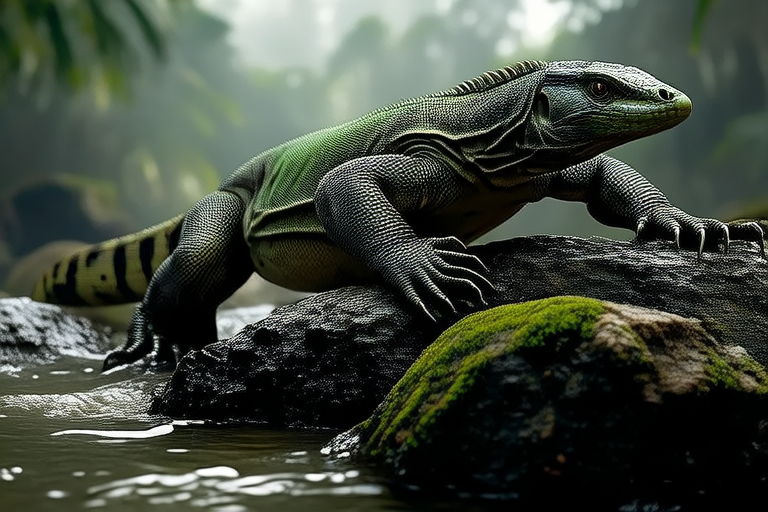Meet the Water Monitor: Nature’s Stealthy Swimmer and Climber
The water monitor (Varanus salvator) is one of the largest lizards in the world, known for its remarkable adaptability and versatile lifestyle. Native to South and Southeast Asia, these reptiles have carved out niches in diverse ecosystems, from dense rainforests to mangrove swamps and freshwater lakes. This article delves into the fascinating world of the water monitor, exploring its physical characteristics, behaviors, and the critical role it plays in maintaining ecological balance.
Habitats and Distribution
Water monitors inhabit a wide range of environments across their native regions, including India, Sri Lanka, Bangladesh, Myanmar, Thailand, Malaysia, Indonesia, and the Philippines. They thrive in areas characterized by high humidity and abundant water bodies. These lizards can be found in coastal regions, riverbanks, and even urban areas near human settlements. Their adaptability allows them to survive in both pristine and disturbed environments, making them a resilient species.
Physical Characteristics
Water monitors are impressive creatures, reaching lengths of up to three meters and weighing over 30 kilograms. Their streamlined bodies are covered in tough, scaly skin that provides protection against predators and environmental hazards. The scales on their bellies are particularly strong, aiding in climbing and swimming. The long, muscular tail is prehensile, which means it can grasp and assist in movement. This feature is crucial for both swimming and climbing trees.
One of the most striking features of the water monitor is its sharp claws. These claws are perfect for digging burrows, climbing trees, and tearing through tough prey. Their powerful limbs, equipped with webbed feet, make them efficient swimmers. The webbing between their toes increases surface area, providing better propulsion in water. Additionally, their nostrils are positioned high on their snouts, allowing them to breathe while partially submerged.
Diet and Behavior
Water monitors are opportunistic feeders with a diet that varies based on availability. Their menu includes fish, crabs, frogs, birds, small mammals, and even other reptiles. They also consume eggs and carrion, demonstrating their adaptability as scavengers. Hunting primarily occurs during the day, and they use their keen eyesight and sense of smell to locate prey. Once they spot potential food, they employ stealth and speed to catch it.
These lizards are known for their agility and intelligence. They can climb trees to escape threats or to find higher ground when water levels rise. In times of danger, they can drop into the water and swim away rapidly. Their ability to hold their breath for up to 30 minutes makes them formidable underwater hunters. They can dive deep and remain submerged for extended periods, allowing them to hunt fish and crustaceans effectively.
Unique Survival Tactics and Hunting Strategies
Water monitors exhibit several unique survival tactics. One of their most remarkable abilities is their capacity to detect vibrations in the ground, helping them locate prey or avoid danger. They can also produce a foul-smelling secretion from glands near their cloaca, which deters predators and warns other monitors of potential threats. When threatened, they can inflate their bodies to appear larger and more intimidating.
In terms of hunting, water monitors are patient and strategic. They often wait in ambush at the water’s edge, ready to pounce on unsuspecting prey. Their sharp teeth and strong jaws allow them to deliver powerful bites, subduing even large prey. Once caught, they drag their victims to safer locations before consuming them. Monitors are also known to follow vultures and other scavengers to carcasses, where they take advantage of the feast.
Interaction with the Environment
Water monitors play a significant role in their ecosystems. As scavengers, they help control populations of smaller animals and contribute to nutrient cycling by consuming dead organisms. Their presence in aquatic environments helps maintain biodiversity by keeping fish and crustacean populations in check. Additionally, their burrowing activities improve soil aeration and water infiltration, benefiting plant growth.
Their interactions with humans are varied. In some cultures, water monitors are revered and protected, while in others, they are hunted for their meat and skins. Despite these challenges, they continue to thrive in many parts of their range, thanks to their resilience and adaptability.
Conservation Efforts
Despite their widespread distribution, water monitors face numerous threats, including habitat loss due to deforestation, pollution, and climate change. Urbanization and agricultural expansion encroach upon their natural habitats, reducing available space and resources. Additionally, illegal trade for the pet industry and traditional medicine poses a significant threat to their populations.
Conservation efforts focus on protecting their habitats and raising awareness about the importance of preserving these remarkable creatures. Many organizations work to educate local communities about the value of water monitors and promote sustainable practices. Protected areas and wildlife sanctuaries provide safe havens for these lizards, ensuring their continued survival.
The Importance of Preserving Natural Habitats
The preservation of water monitors’ habitats is crucial for maintaining ecological balance. By protecting their environments, we safeguard not only the monitors but also countless other species that depend on these ecosystems. Conserving wetlands, forests, and other critical habitats ensures that future generations can appreciate the beauty and complexity of nature.
Moreover, preserving these habitats benefits humanity. Healthy ecosystems provide essential services, such as clean air and water, flood control, and carbon sequestration. By supporting conservation initiatives, we contribute to a healthier planet and a more sustainable future.
In conclusion, the water monitor is a marvel of evolution, perfectly adapted to its environment. Its physical attributes, behaviors, and interactions with its surroundings make it a vital component of its ecosystem. As stewards of the Earth, it is our responsibility to protect these incredible creatures and the habitats that sustain them. By doing so, we ensure the survival of this remarkable species and the countless others that call these environments home.
